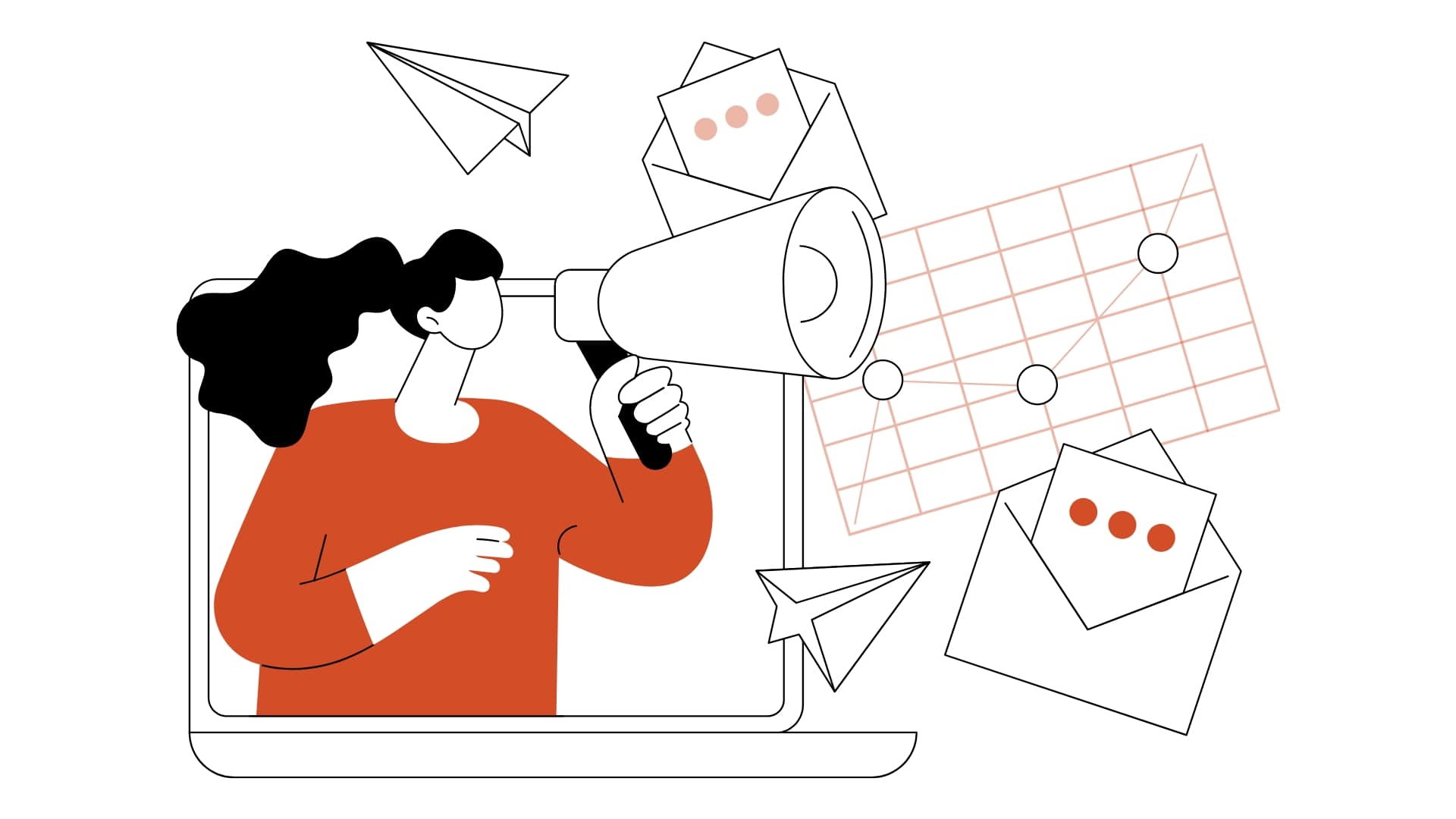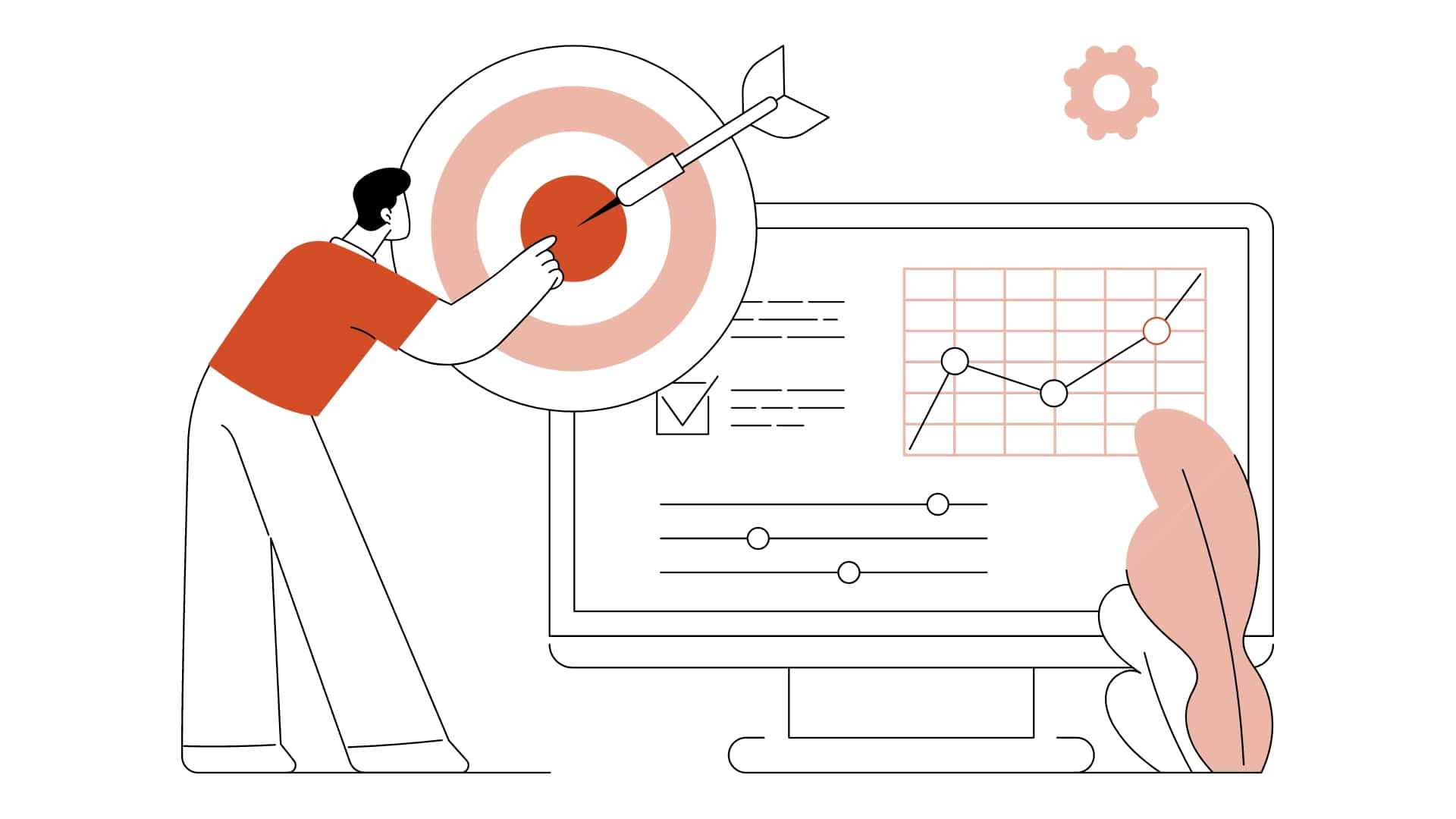- What is event support?
- Why is it important to support marketing programs?
- Who is responsible for providing internal and external marketing program support?
- What information is needed for event marketing?
- How to provide effective support for in-person marketing events
- How to provide effective support for online marketing events
- How to measure the success of event marketing
- Event marketing mistakes to avoid
The Product Marketer’s Guide to Supporting Marketing Events
Marketing events, such as conferences, trade shows and webinars, are one of the most powerful ways to connect with customers, build relationships and gather sales leads. Planning a successful event can be a herculean task, and creating a memorable event experience doesn’t happen by accident. It takes planning, collaboration and efficient delivery. Don’t let all of your marketing efforts go to waste.
By understanding the importance of event marketing, who’s responsible for it, how to provide effective support, the mistakes to avoid and how to measure its effectiveness, you’ll be equipped with the know-how to support successful marketing events to drive audience engagement, increase attendance rates and deliver greater ROI for your organization.
What is event support?
Conferences, trade shows, webinars and regional meetings are all important ways to connect with your customers. To ensure your company attracts the most relevant customers and prospects and plans the most valuable event content, it’s essential for product managers to provide essential market and solution information to support these events.

Lorem ipsum dolor sit amet, consectetur adipiscing elit. Maecenas dictum mi quis lacus tempor luctus.
Why is it important to support marketing programs?
Event marketing is a cornerstone for any business or enterprise that hosts events, regardless of size. Successful corporate event planning offers many potential benefits, including:- Increasing brand awareness
- Building brand affinity
- Establishing and developing relationships
- Increasing leads
- Promoting products and/or improving sales
- Increasing the customer database
- Brand credibility and thought leadership
- Increasing ROI

Lorem ipsum dolor sit amet, consectetur adipiscing elit. Maecenas dictum mi quis lacus tempor luctus.
Who is responsible for providing internal and external marketing program support?
Product managers can supply valuable insights that can significantly improve your event marketing messaging. For example, they can help articulate the product features that users value the most, users’ problems (including words used to define these problems) and product benefits they are looking for.
Knowing customers’ pain points can boost your event marketing campaign initiatives significantly. That can take the form of more effective website content, social media ads or email marketing.
What information is needed for event marketing
Few events have more power to build customer loyalty than holding a customer conference. But planning goes way beyond simply when and where your conference will take place and what kind of chicken to serve.
It’s important to assess your product’s—and your organization’s—situation and goals and determine your aim for a customer conference, then make strategic and tactical decisions accordingly. To find out what your customers really want, you can rely on:
- Surveys: Create simple, short online surveys to better match your conference to expectations. You also can poll customers before and during conference sessions to get a feel for what they most want and change course accordingly.
- Research and data: Use Google Trends to uncover industry themes that may be on your prospects’ minds. Check your Google Analytics stats for high-traffic areas to target insightful webinar discussions. Review your webmaster feedback for any recurring themes.
- Product manager insights: Product managers can provide good input on customer needs and preferences, as well as what your company needs from its customer base, to ensure that important decisions are made to create a successful customer experience.
How to provide effective support for in-person marketing events
There are several different types of in-person marketing events, and they each require a slightly different type of support from product managers.
Customer conferences: To plan a conference that creates the most valuable experience for your customers, take these three steps:
- Define the goals you want to accomplish with your customer conference.
- Describe the results you are aiming for to accomplish that goal.
- Outline the strategies and tactics needed to attain those results.
Here’s an example of that process:
1. The goal of our customer conference is to improve the gross margin for our product. A healthy gross margin is a sign of a fundamentally healthy and sound business, one that will make good money that can be put back into product development and company growth.
2. The customer conference will improve gross margin by:
- Increasing revenues by generating add-on sales with existing customers
- Building customer loyalty, which will increase maintenance revenue and renewals
- Enhancing customer success with the product, which will lead to word-of-mouth advertising and press coverage, cutting down on marketing costs
3. Strategies: The goals above point to a strategy of presentations where customer stories and successes are featured. You also want to provide customers with plenty of time for networking. Remember that different customers have different goals, which might require you to offer multiple tracks—high-level for managers and how-tos for end users—to suit differing customer agendas.
4. Tactics: A customer conference with presentations that focus on strategy and successes, with meals, receptions, or other activities that help customers network and get to know each other. Training classes would be optional unless customer feedback indicated a strong desire for them.
Trade shows: Exhibiting at industry conferences and trade shows is a staple of marketing software and other products because these events provide visibility for your product, build familiarity and bring in sales leads. But they are a guaranteed expense with no guaranteed return.
As a product manager, conferences and trade shows where you are exhibiting should be used as a time to learn not to sell. Gather insights about customers and prospects and their needs as well as what they think of your product and your competition.
Although it is important to staff your booth, take an opportunity to walk the exhibit floor and learn there as well. Check in on competitors to gather information to bring back to the office. Evaluate the marketing messages and promotional campaigns of other vendors, and make a list of things you can do to improve your booth for the next conference.
How to provide effective support for online marketing events
Online events like webinars are low-cost and easy to set up and can help generate new leads for your company and speed up the sales cycle. Here are a few ways to support online marketing events:
- Promote like a pro: The event’s core marketing message should focus on the benefits of attending. Be sure to promote the webinar using the same social media platforms your prospects use.
- Increase attendance: Craft a marketing message that persuades subscribers to actually attend the webinar. Increase your odds of success by sending email invites at least seven days before the event and reminders 24 hours and a few hours before the webinar.
- Follow up after: After the webinar, these tips will help keep your brand top of mind:
- Post the webinar as a download on your website to grow your opt-in list.
- Share your webinar on popular B2B channels such as Slideshare.
- Send attendees a thank-you email within 24 hours with a link to the archived webinar.
- Send an email with a link to those who registered but did not attend.
- Send a short survey to get immediate feedback and ideas for future webinars.
- Measure your performance. How many people attended compared to those who registered? How did your landing pages perform? What did polls say about the audience’s experience? How many new leads and customers did the event generate?
Webinars aren’t the only online events that get results. These activities also encourage customer engagement:
- AMA or “Ask Me Anything” sessions have an expert host or thought leader who fields questions from the rest of the community. These can be done via a webinar, on social media platforms or as a blog if questions are solicited via email. They’re an effective tool to communicate transparency and authenticity.
- Show-and-Tell or Round Robin events can be used to create a deep connection with customers and build loyalty. Host a shared online chat space or video conferencing session where you suggest a topic and have each participant share a mini-case study about how they approach it.
- Office Hours or Coffee Chats are led by a facilitator who hosts an online open house where people can drop in and out as they want.
How to measure the success of event marketing
If you’re putting on your own customer conference, you need to measure the payoff to justify the payout. To do that:
- Tally up the total costs: Consider fees for the venue, food and other hard expenses. Don’t forget employee travel and expenses as well as total person-days for prep work and attendance—and figure out an average cost per customer attendee.
- Ask for feedback: Hand out written surveys at the end of the conference and after individual sessions. Gather feedback, analyze it and present your findings to the management team. Look at overall satisfaction to help determine whether the investment has paid off in terms of feelings of customer loyalty.
- Go back to your goal: Evaluate how well your event accomplished the goals and results you established.
- Look at lessons learned: After the conference, use the experience, failures and successes to provide a better event next time.
Measuring the success of trade show attendance looks slightly different. A trade show can easily eat up a week of your time between travel, setup and the show itself, so it’s vital that you attend only those trade shows that net you a positive return on investment (ROI). Positive benefits of trade show attendance include:
- Marketing and sales leads
- Industry exposure
- Partnerships and alliances
- Speaking engagements
- Trade show sponsorships
Add up the estimated return against total costs: booth space, materials, shipping and setup, travel and expenses for all attendees. Is the return more or less than the cost? That’s one measurement. Next, if you spent the same money on something else—seminars, telemarketing, advertising—could you get a better result? The answer to these two questions should tell you pretty clearly whether the trade show is worth it.
Event marketing mistakes to avoid
Marketing events can be a bit tricky because of the many elements to be taken into consideration. Success in event marketing lies in the ability to mitigate disasters before they occur. It’s always better to be over-prepared and know how to avoid these five most common mistakes:
- Not communicating with other departments: Encourage collaboration among departments by clarifying designated roles, using a shared calendar to communicate deadlines and holding meetings to update everyone concerned and get feedback on potential issues.
- Not timing the pre-event buzz appropriately: Promoting an event too early forces marketers to work hard at maintaining audience interest. Late event promotion reduces lead time, resulting in a decrease in audience attendance.
- Not leveraging the resources of sponsors and partnerships: Sponsors, vendors, speakers and exhibitors each have their own network of high-quality consumers that can be leveraged as new marketing opportunities for your event. To reach these potential attendees, provide value through partnership event marketing.
- Over-promising and under-delivering: Building too much hype and not being able to deliver can result in a PR nightmare and leave attendees disappointed, which makes them less likely to participate in future events.
- Ignoring post-event marketing: Post-event marketing is equally (if not more) important than pre-event marketing. When done right, post-event marketing can convert leads into sales, allow your business to nurture potential customers into loyal brand advocates and help measure the success of the event. Successful post-event marketing should include:
- A post-event survey
- Follow-up networking events
- Repurposing event content to showcase event highlights
- Thank-you emails
- Extended event-only offers (e.g., product launch discounts, service promotions)
Learn more about supporting marketing events
By understanding the importance of marketing events to your customers and your bottom line, you can learn what information you can provide, mistakes to avoid and how you can best support them. Learn this and more in Pragmatic Institute’s Launch course today.




